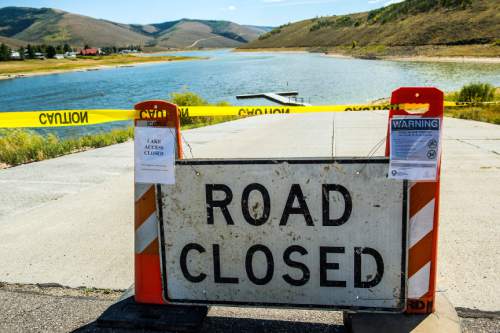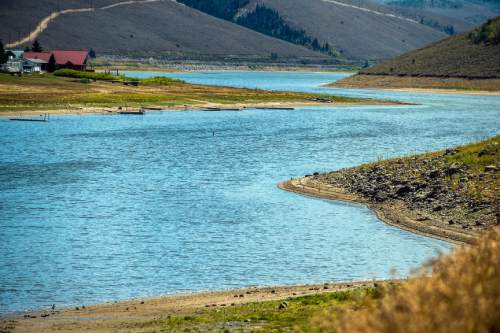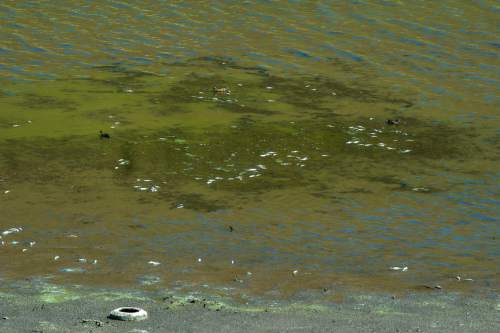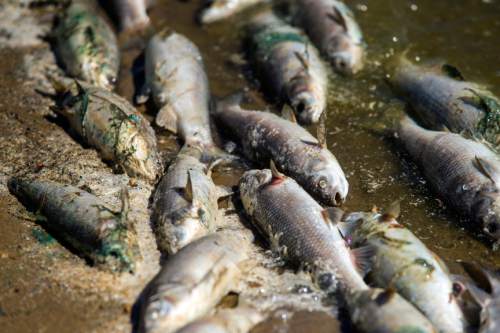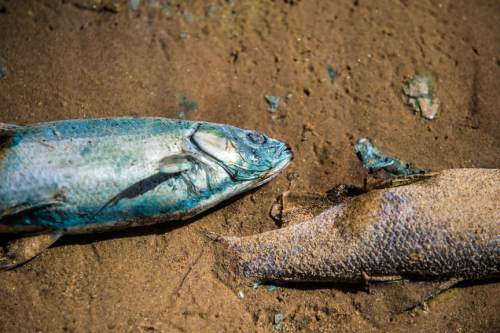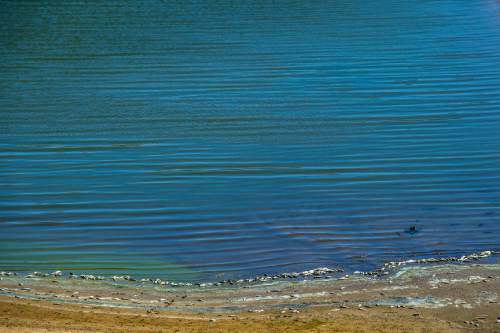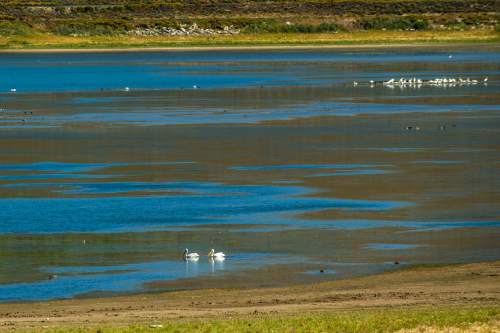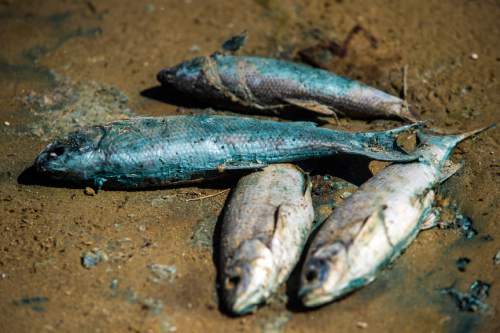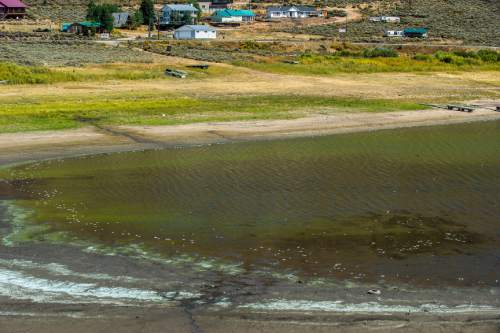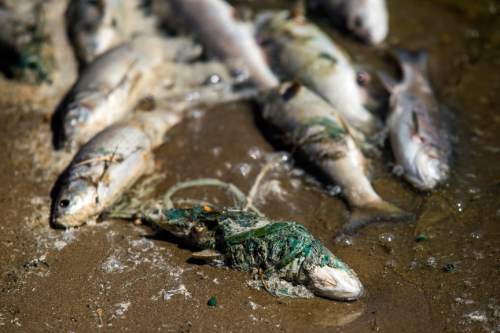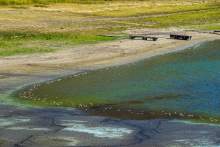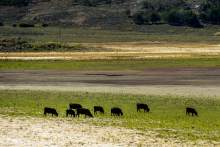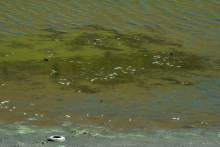Chris Detrick | The Salt Lake Tribune
An algal bloom at Scofield Reservoir in Carbon County Wednesday August 31, 2016. A growing
Chris Detrick | The Salt Lake Tribune
An algal bloom at Scofield Reservoir in Carbon County Wednesday August 31, 2016. A growing
Chris Detrick | The Salt Lake Tribune
Dead fish from an algal bloom at Scofield Reservoir in Carbon County Wednesday August 31,
Chris Detrick | The Salt Lake Tribune
Dead fish from an algal bloom at Scofield Reservoir in Carbon County Wednesday August 31,
Chris Detrick | The Salt Lake Tribune
Dead fish from an algal bloom at Scofield Reservoir in Carbon County Wednesday August 31,
Chris Detrick | The Salt Lake Tribune
Dead fish from an algal bloom at Scofield Reservoir in Carbon County Wednesday August 31,
Chris Detrick | The Salt Lake Tribune
Dead fish from an algal bloom at Scofield Reservoir in Carbon County Wednesday August 31,
Chris Detrick | The Salt Lake Tribune
A deer near at Scofield Reservoir in Carbon County Wednesday August 31, 2016. A growing al
Chris Detrick | The Salt Lake Tribune
Dead fish from an algal bloom at Scofield Reservoir in Carbon County Wednesday August 31,
Chris Detrick | The Salt Lake Tribune
Dead fish from an algal bloom at Scofield Reservoir in Carbon County Wednesday August 31,
Chris Detrick | The Salt Lake Tribune
Cattle graze near Scofield Reservoir in Carbon County Wednesday August 31, 2016. A growing
Chris Detrick | The Salt Lake Tribune
An algal bloom at Scofield Reservoir in Carbon County Wednesday August 31, 2016. A growing
Chris Detrick | The Salt Lake Tribune
Dead fish from an algal bloom at Scofield Reservoir in Carbon County Wednesday August 31,
Chris Detrick | The Salt Lake Tribune
Dead fish from an algal bloom at Scofield Reservoir in Carbon County Wednesday August 31,
Chris Detrick | The Salt Lake Tribune
Dead fish from an algal bloom at Scofield Reservoir in Carbon County Wednesday August 31,
Chris Detrick | The Salt Lake Tribune
An algal bloom at Scofield Reservoir in Carbon County Wednesday August 31, 2016. A growing algal bloom at Scofield Reservoir forced officials to close the popular Carbon County fishery to boating and swimming Wednesday until further notice. The Southeast Utah Health Department made the decision after lab results were returned showing escalating levels of cyanobacteria at Mountain View boat ramp at Scofield State Park and other places on the 2,800-acre lake nestled at 7,600 feet above sea level in the Price River's headwaters.
Chris Detrick | The Salt Lake Tribune
An algal bloom at Scofield Reservoir in Carbon County Wednesday August 31, 2016. A growing algal bloom at Scofield Reservoir forced officials to close the popular Carbon County fishery to boating and swimming Wednesday until further notice. The Southeast Utah Health Department made the decision after lab results were returned showing escalating levels of cyanobacteria at Mountain View boat ramp at Scofield State Park and other places on the 2,800-acre lake nestled at 7,600 feet above sea level in the Price River's headwaters.
Chris Detrick | The Salt Lake Tribune
Dead fish from an algal bloom at Scofield Reservoir in Carbon County Wednesday August 31, 2016. A growing algal bloom at Scofield Reservoir forced officials to close the popular Carbon County fishery to boating and swimming Wednesday until further notice. The Southeast Utah Health Department made the decision after lab results were returned showing escalating levels of cyanobacteria at Mountain View boat ramp at Scofield State Park and other places on the 2,800-acre lake nestled at 7,600 feet above sea level in the Price River's headwaters.
Chris Detrick | The Salt Lake Tribune
Dead fish from an algal bloom at Scofield Reservoir in Carbon County Wednesday August 31, 2016. A growing algal bloom at Scofield Reservoir forced officials to close the popular Carbon County fishery to boating and swimming Wednesday until further notice. The Southeast Utah Health Department made the decision after lab results were returned showing escalating levels of cyanobacteria at Mountain View boat ramp at Scofield State Park and other places on the 2,800-acre lake nestled at 7,600 feet above sea level in the Price River's headwaters.
Chris Detrick | The Salt Lake Tribune
Dead fish from an algal bloom at Scofield Reservoir in Carbon County Wednesday August 31, 2016. A growing algal bloom at Scofield Reservoir forced officials to close the popular Carbon County fishery to boating and swimming Wednesday until further notice. The Southeast Utah Health Department made the decision after lab results were returned showing escalating levels of cyanobacteria at Mountain View boat ramp at Scofield State Park and other places on the 2,800-acre lake nestled at 7,600 feet above sea level in the Price River's headwaters.
Chris Detrick | The Salt Lake Tribune
Dead fish from an algal bloom at Scofield Reservoir in Carbon County Wednesday August 31, 2016. A growing algal bloom at Scofield Reservoir forced officials to close the popular Carbon County fishery to boating and swimming Wednesday until further notice. The Southeast Utah Health Department made the decision after lab results were returned showing escalating levels of cyanobacteria at Mountain View boat ramp at Scofield State Park and other places on the 2,800-acre lake nestled at 7,600 feet above sea level in the Price River's headwaters.
Chris Detrick | The Salt Lake Tribune
Dead fish from an algal bloom at Scofield Reservoir in Carbon County Wednesday August 31, 2016. A growing algal bloom at Scofield Reservoir forced officials to close the popular Carbon County fishery to boating and swimming Wednesday until further notice. The Southeast Utah Health Department made the decision after lab results were returned showing escalating levels of cyanobacteria at Mountain View boat ramp at Scofield State Park and other places on the 2,800-acre lake nestled at 7,600 feet above sea level in the Price River's headwaters.
Chris Detrick | The Salt Lake Tribune
A deer near at Scofield Reservoir in Carbon County Wednesday August 31, 2016. A growing algal bloom at Scofield Reservoir forced officials to close the popular Carbon County fishery to boating and swimming Wednesday until further notice. The Southeast Utah Health Department made the decision after lab results were returned showing escalating levels of cyanobacteria at Mountain View boat ramp at Scofield State Park and other places on the 2,800-acre lake nestled at 7,600 feet above sea level in the Price River's headwaters.
Chris Detrick | The Salt Lake Tribune
Dead fish from an algal bloom at Scofield Reservoir in Carbon County Wednesday August 31, 2016. A growing algal bloom at Scofield Reservoir forced officials to close the popular Carbon County fishery to boating and swimming Wednesday until further notice. The Southeast Utah Health Department made the decision after lab results were returned showing escalating levels of cyanobacteria at Mountain View boat ramp at Scofield State Park and other places on the 2,800-acre lake nestled at 7,600 feet above sea level in the Price River's headwaters.
Chris Detrick | The Salt Lake Tribune
Dead fish from an algal bloom at Scofield Reservoir in Carbon County Wednesday August 31, 2016. A growing algal bloom at Scofield Reservoir forced officials to close the popular Carbon County fishery to boating and swimming Wednesday until further notice. The Southeast Utah Health Department made the decision after lab results were returned showing escalating levels of cyanobacteria at Mountain View boat ramp at Scofield State Park and other places on the 2,800-acre lake nestled at 7,600 feet above sea level in the Price River's headwaters.
Chris Detrick | The Salt Lake Tribune
Cattle graze near Scofield Reservoir in Carbon County Wednesday August 31, 2016. A growing algal bloom at Scofield Reservoir forced officials to close the popular Carbon County fishery to boating and swimming Wednesday until further notice. The Southeast Utah Health Department made the decision after lab results were returned showing escalating levels of cyanobacteria at Mountain View boat ramp at Scofield State Park and other places on the 2,800-acre lake nestled at 7,600 feet above sea level in the Price River's headwaters.
Chris Detrick | The Salt Lake Tribune
An algal bloom at Scofield Reservoir in Carbon County Wednesday August 31, 2016. A growing algal bloom at Scofield Reservoir forced officials to close the popular Carbon County fishery to boating and swimming Wednesday until further notice. The Southeast Utah Health Department made the decision after lab results were returned showing escalating levels of cyanobacteria at Mountain View boat ramp at Scofield State Park and other places on the 2,800-acre lake nestled at 7,600 feet above sea level in the Price River's headwaters.
Chris Detrick | The Salt Lake Tribune
Dead fish from an algal bloom at Scofield Reservoir in Carbon County Wednesday August 31, 2016. A growing algal bloom at Scofield Reservoir forced officials to close the popular Carbon County fishery to boating and swimming Wednesday until further notice. The Southeast Utah Health Department made the decision after lab results were returned showing escalating levels of cyanobacteria at Mountain View boat ramp at Scofield State Park and other places on the 2,800-acre lake nestled at 7,600 feet above sea level in the Price River's headwaters.
Chris Detrick | The Salt Lake Tribune
Dead fish from an algal bloom at Scofield Reservoir in Carbon County Wednesday August 31, 2016. A growing algal bloom at Scofield Reservoir forced officials to close the popular Carbon County fishery to boating and swimming Wednesday until further notice. The Southeast Utah Health Department made the decision after lab results were returned showing escalating levels of cyanobacteria at Mountain View boat ramp at Scofield State Park and other places on the 2,800-acre lake nestled at 7,600 feet above sea level in the Price River's headwaters.
Chris Detrick | The Salt Lake Tribune
Dead fish from an algal bloom at Scofield Reservoir in Carbon County Wednesday August 31, 2016. A growing algal bloom at Scofield Reservoir forced officials to close the popular Carbon County fishery to boating and swimming Wednesday until further notice. The Southeast Utah Health Department made the decision after lab results were returned showing escalating levels of cyanobacteria at Mountain View boat ramp at Scofield State Park and other places on the 2,800-acre lake nestled at 7,600 feet above sea level in the Price River's headwaters.


